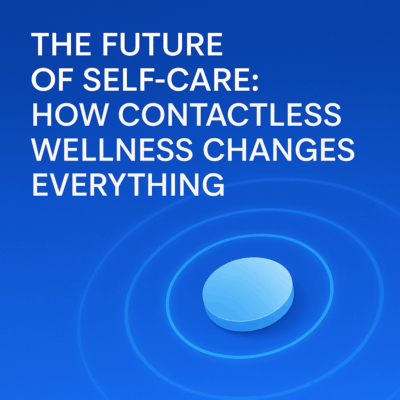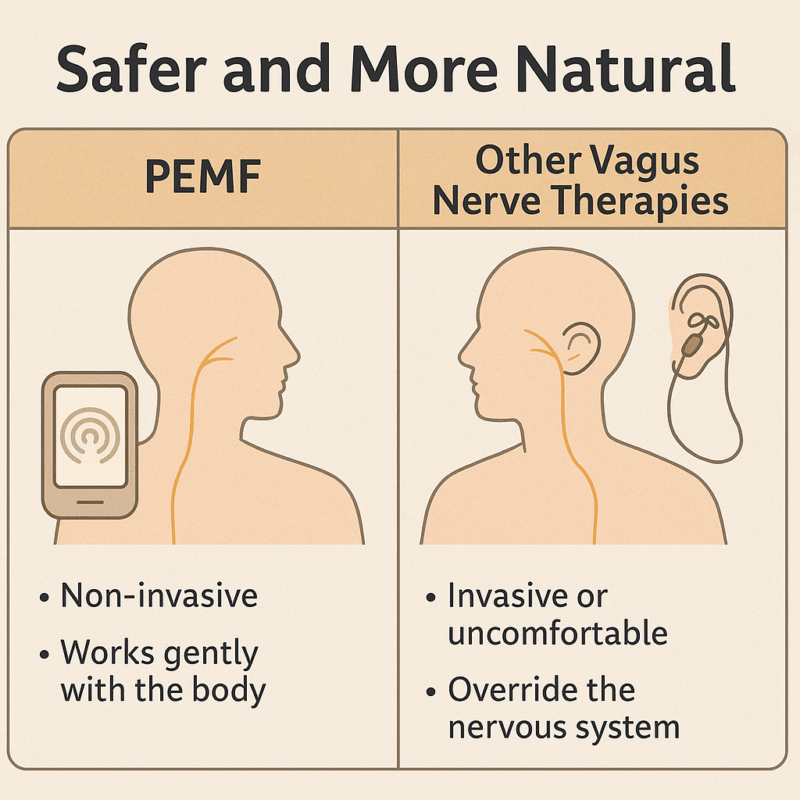
The Future of Self-Care: How Contactless Wellness Changes Everything
Contactless Wellness: A New Way to Feel Well The next generation of self-care isn’t about what you wear…

PEMF vs. Other Vagus Nerve Therapies: What Makes It Safer and More Natural The vagus nerve has become one of the most fascinating topics in modern wellness and neuroscience. As research continues to uncover its role in regulating stress, sleep, inflammation, and digestion, interest in therapies that can stimulate and strengthen vagal tone has skyrocketed. […]
Table of Contents
The vagus nerve has become one of the most fascinating topics in modern wellness and neuroscience. As research continues to uncover its role in regulating stress, sleep, inflammation, and digestion, interest in therapies that can stimulate and strengthen vagal tone has skyrocketed.
Today, there are several approaches available — from invasive medical implants to simple breathing exercises. But not all vagus nerve therapies are created equal. In this article, we’ll explore how PEMF (Pulsed Electromagnetic Field) therapy compares to other methods, and why many consider it a safer and more natural choice.
The vagus nerve acts as a communication highway between the brain and major organs, including the heart, lungs, and digestive system. It helps regulate the parasympathetic nervous system — often called the “rest-and-digest” system.
When vagal activity is strong (good vagal tone), the body can calm itself, sleep more deeply, digest food efficiently, and keep inflammation under control. When vagal tone is weak, stress dominates, sleep suffers, and digestion slows down.
This is why therapies that improve vagus nerve function are gaining so much attention.
In clinical settings, surgically implanted devices are sometimes used to deliver electrical impulses directly to the vagus nerve. These are primarily prescribed for epilepsy or treatment-resistant depression.
Pros: Strong clinical evidence for certain medical conditions.
Cons: Highly invasive, expensive, potential complications from surgery, and not accessible for everyday wellness use.
These are non-invasive devices placed on the ear or neck that deliver small electrical impulses through the skin to stimulate vagus nerve branches.
Pros: Non-surgical, growing body of research.
Cons: Can feel uncomfortable (tingling, stinging), limited to surface nerve branches, and may require medical oversight.
Certain techniques naturally stimulate the vagus nerve: deep breathing, meditation, yoga, cold exposure, chanting, and humming.
Pros: Completely natural, accessible, safe.
Cons: Require consistent practice and discipline; effects may be subtle or slower to develop.
Pulsed Electromagnetic Field therapy uses gentle, low-frequency magnetic fields to interact with the body’s cells and nervous system. Devices are applied externally, without surgery or skin penetration.
Pros: Non-invasive, comfortable, natural-feeling, easy to use at home.
Cons: As with any wellness technology, effects vary between individuals, and more clinical research is still emerging.
Completely Non-Invasive
Unlike implanted stimulators, PEMF devices do not require surgery, wires, or direct contact with nerves. They work externally and gently, making them far safer for general wellness.
Comfortable and Painless
Electrical stimulation (tVNS) can cause tingling or discomfort. PEMF, on the other hand, is often described as soothing, with no sharp or irritating sensations.
Supports the Body’s Natural Rhythms
PEMF doesn’t override the nervous system; it works in harmony with natural bioelectrical processes. This makes it more aligned with how the vagus nerve functions in daily life.
Broad Systemic Benefits
While tVNS devices often target only small nerve branches, PEMF can influence deeper pathways and support overall balance in the autonomic nervous system — which translates into improvements in stress resilience, sleep quality, and digestion.
Accessible for Daily Use
PEMF devices are easy to use at home without medical supervision, unlike implantable therapies or some electrical stimulators that require a clinic.
As research expands, therapies targeting the vagus nerve will continue to grow. Surgical implants will remain necessary for certain severe medical conditions, while lifestyle practices will always be powerful foundations of wellness.
But for individuals looking for a safe, natural, and effective way to support vagus nerve health at home, PEMF therapy offers a unique balance: modern technology that enhances the body’s natural processes without the risks of invasive procedures or the discomfort of electrical stimulation.
The vagus nerve is central to health, influencing how we handle stress, how well we sleep, and how smoothly our digestion works. While there are many ways to support vagal tone, PEMF therapy provides a gentle, natural, and non-invasive option that stands apart from more aggressive or less comfortable alternatives.